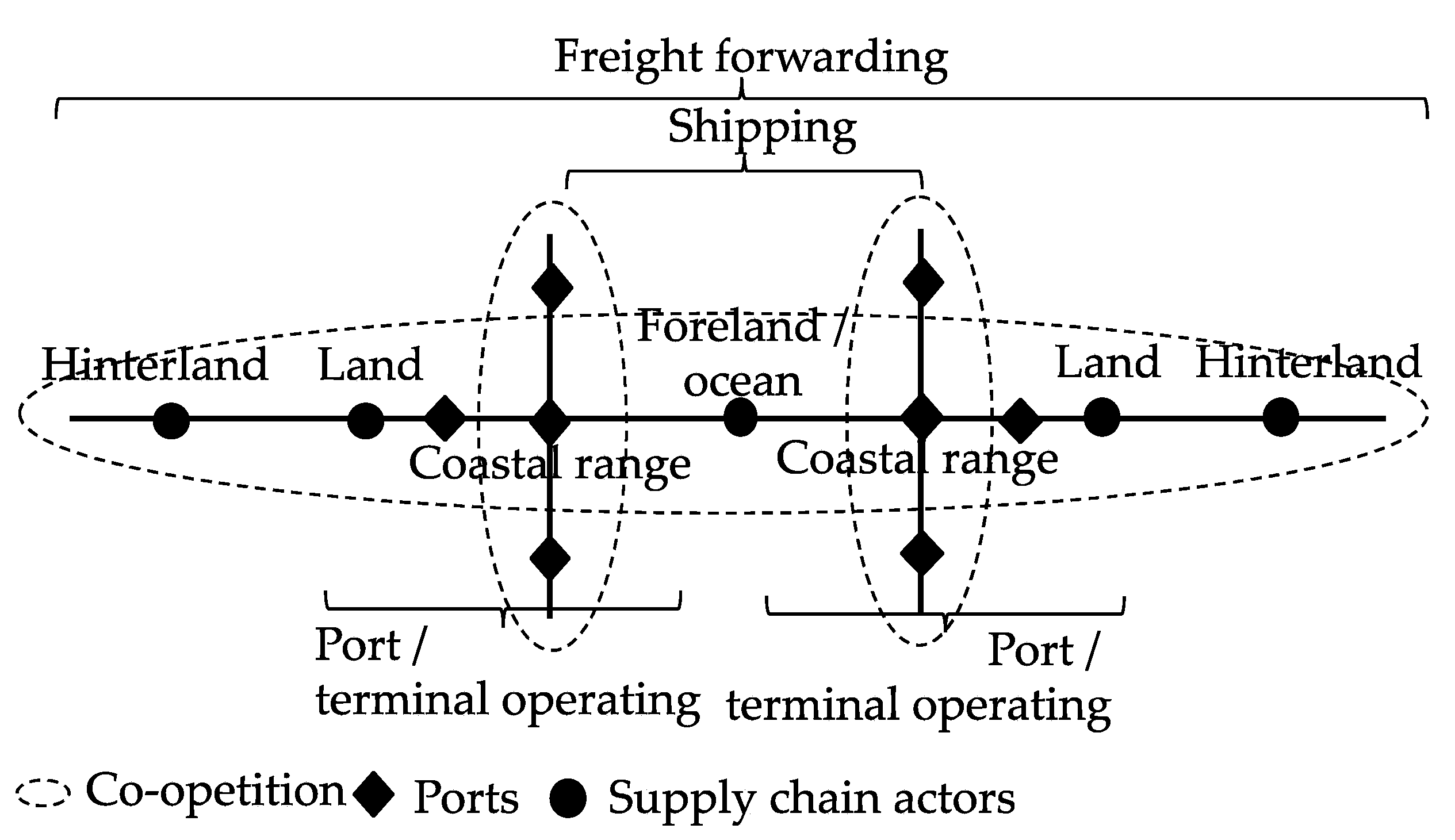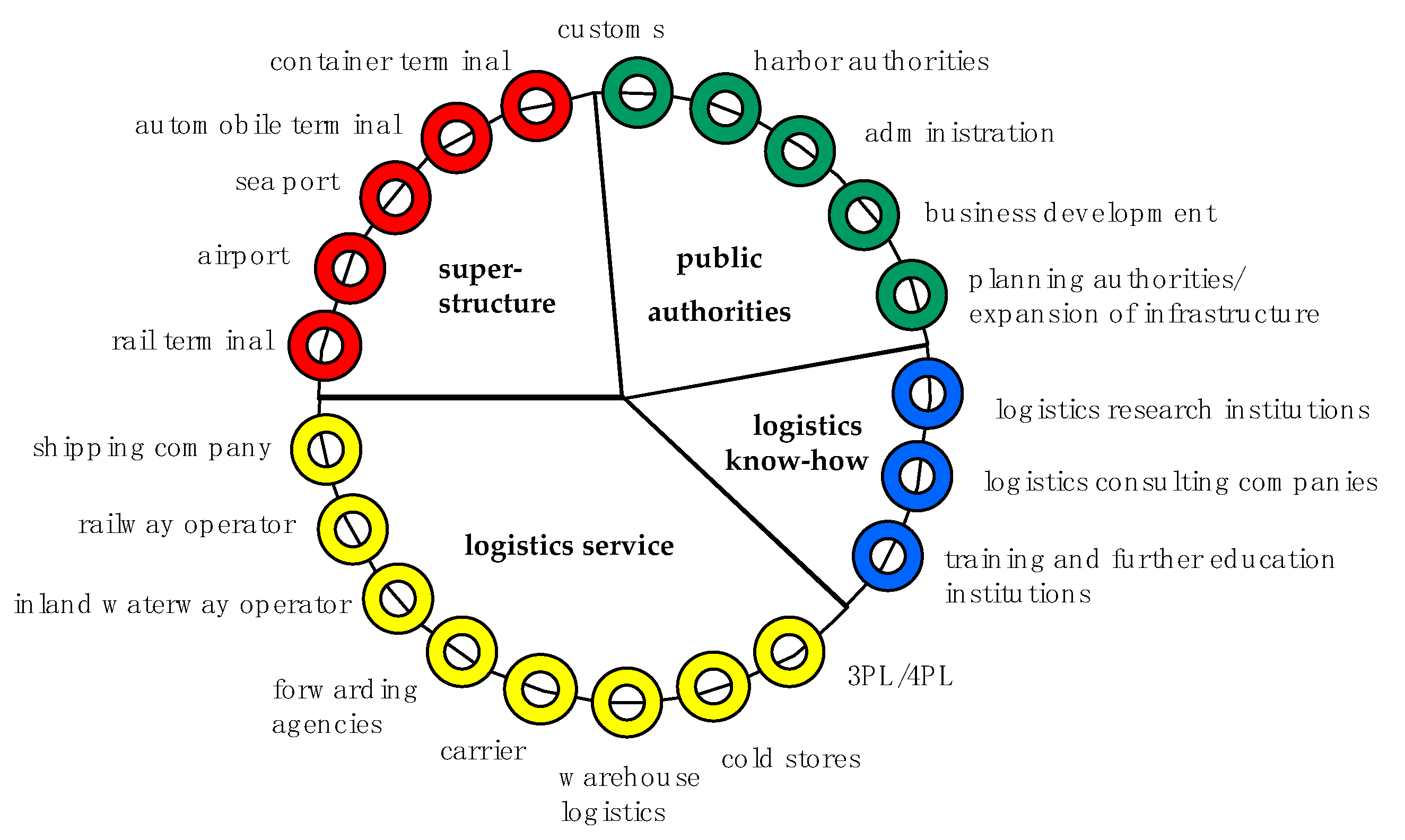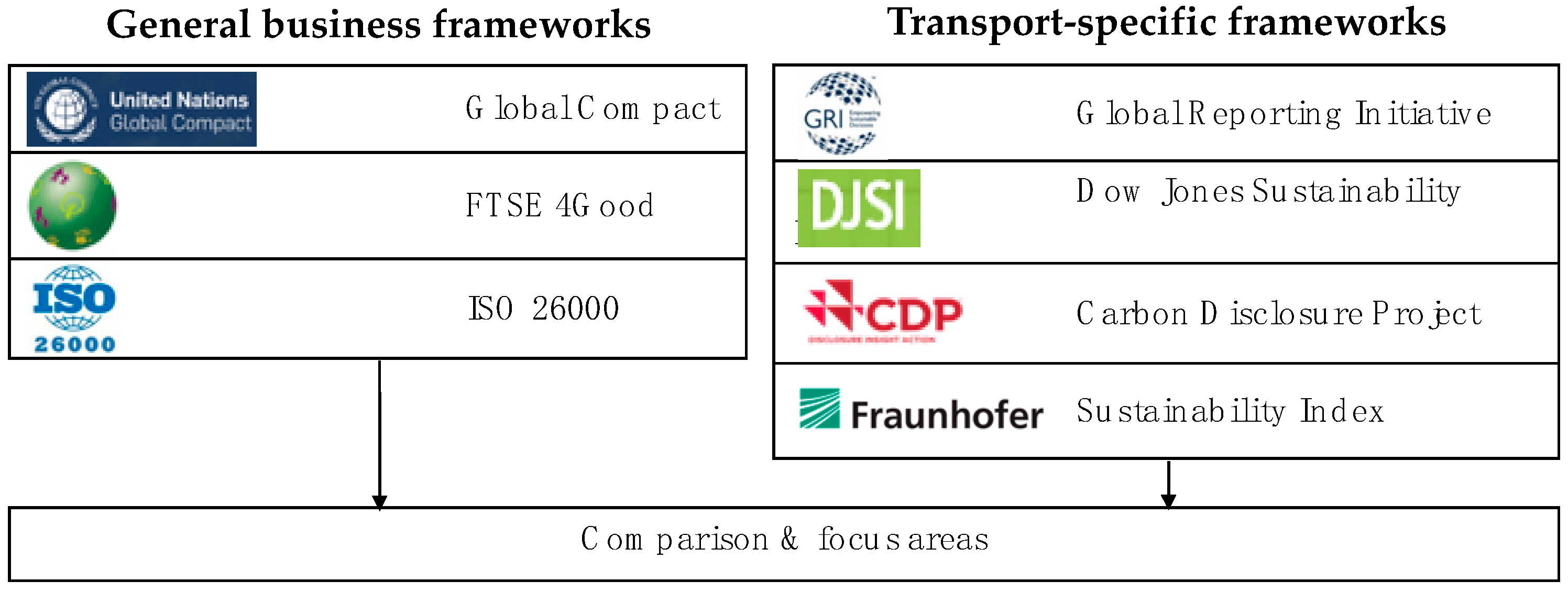Sustainable Firm Performance of Logistics Service Providers along Maritime Supply Chain
Abstract
:1. Introduction
2. Aims and Research Concept
- (1)
- What are the decisive components for the sustainability performance of LSPs?
- (2)
- Which capabilities can be used as sustainability-oriented indicators?
3. An Overview of Sustainability Frameworks
4. Evidence-Based Actions on How to Enhance Performance
- perform* OR efficien* OR productiv* OR effective*
- logist* OR suppl* OR transp*.
5. Concluding Remarks
- Sustainability is considered in maritime logistics. However, there is less accordance in terms of what to focus on for LSPs if they address the outlined sustainability frameworks. Furthermore, all non-UN-frameworks lack in addressing and linking to SDGs. No sustainability framework offers a minimum list on which criteria for each sustainability dimension to focus on for LSPs.
- The positive influence of considering sustainability is confirmed in the selected quantitative studies showing the collected evidence to analyze the empirical data about LSP in advanced economies. The evidence-based influence of considering environmental and social dimensions of sustainability is underrepresented in qualitative and quantitative studies. The identified focus areas for each sustainability dimension in the literature differ from those of sustainability frameworks.
- The convergence between quantitative and qualitative studies in terms of the identified components of performance is high. The points of interface of qualitative and quantitative studies are components of performance and the proposed metrics. Different aspects of the same topic (points of unexplained divergence) occur since quantitative studies test the effects of capabilities on performance, while qualitative studies track the relations between performance components.
Funding
Institutional Review Board Statement
Informed Consent Statement
Conflicts of Interest
References
- World Trade Organization. WTO Lowers Trade Forecast as Tensions Unsettle Global Economy. 2019. Available online: https://www.wto.org/english/news_e/pres19_e/pr840_e.htm (accessed on 23 June 2021).
- OECD. OECD Economic Outlook, Interim Report March 2020. Available online: https://www.oecd-ilibrary.org/economics/oecd-economic-outlook/volume-2019/issue-2_7969896b-en (accessed on 23 June 2021).
- International Transport Forum. ITF Transport Outlook 2019; OECD Publishing: Paris, France, 2019; Available online: https://www.itf-oecd.org/itf-transport-outlook-2019 (accessed on 23 June 2021).
- United Nations Conference on Transport and Development. Review of Maritime Transport 2019; United Nations: Geneva, Switzerland, 2019; Available online: https://unctad.org/en/PublicationsLibrary/rmt2019_en.pdf (accessed on 23 June 2021).
- Lee, E.-S.; Nam, H.-S.; Song, D.-W. Defining maritime logistics and its value. In Maritime Logistics: A Complete Guide to Effective Shipping and Port Management; Song, D.-M., Panayides, P.M., Eds.; Kogan Page: London, UK, 2012; pp. 9–21. [Google Scholar]
- Haasis, H.-D.; Elbert, R. Bringing regional networks back-into global supply chains: Strategies for logistics service providers as integrators of logistic clusters. In Global Logistics Management: Sustainability, Quality, Risks; Kersten, W., Blecker, T., Flämig, H., Eds.; Erich Schmidt: Berlin, Germany, 2008; pp. 21–31. [Google Scholar]
- Porter, M.E. The Competitive Advantage of Nations: With a New Introduction; Palgrave: Basingstoke, UK, 2007. [Google Scholar]
- Pouder, R.; St. John, C.H. Hot sports and blind spots: Geographical clusters of firms and innovation. Acad. Manag. Rev. 1996, 21, 1192–1225. [Google Scholar] [CrossRef]
- Markusen, A. Sticky Places in Slippery Space: A Typology of Industrial Districts. Econ. Geogr. 1996, 72, 293. [Google Scholar] [CrossRef]
- Brandenburger, A.M.; Nalebuff, B. The Rules of Coopetition. Harv. Bus. Rev. 2021, 99, 48–57. [Google Scholar]
- Dovbischuk, I.; Haasis, H.-D. Path dependency in the process of sustainable regional development of transport and logistics regions: Solutions for sea ports. In Dynamics and Sustainability in International Logistics and Supply Chain Management; Ivanov, D., Kopfer, H., Haasis, H.-D., Eds.; Springer: Göttingen, Germany, 2011; pp. 241–247. [Google Scholar]
- Bird, J. Seaports and Seaport Terminals; Hutchinson University Library: London, UK, 1971. [Google Scholar]
- Hayuth, Y. The Port-Urban Interface: An Area in Transition. Area 1982, 14, 219–224. [Google Scholar]
- Hoyle, B.S. Development dynamics at the port-city interface. In Revitalizing the Waterfront: International Dimensions of Dockland Development; Hoyle, B.S., Pinder, D.A., Husain, S.M., Eds.; Belhaven Press: London, UK, 1988; pp. 3–19. [Google Scholar]
- Hayuth, Y. Inland container terminal-function and rationale. Marit. Policy Manag. 1980, 7, 283–289. [Google Scholar] [CrossRef]
- Notteboom, T.E.; Rodrigue, J.-P. Port regionalization: Towards a new phase in port development. Marit. Policy Manag. 2005, 32, 297–313. [Google Scholar] [CrossRef]
- Merk, O. The Competitiveness of Global Port-Cities: Synthesis Report; OECD Regional Development Working Papers; OECD Publishing: Paris, France, 2013. [Google Scholar] [CrossRef]
- Hoyle, B.S.; Pinder, D.A. Cityport Industrialization and Regional Development: Spatial Analysis and Planning Strategies; Pergamon Press: Oxford, UK, 1981. [Google Scholar]
- World Commission on Environment and Development [Brundtland Commission]. Our Common Future; Oxford University Press: Oxford, UK, 1987. [Google Scholar]
- Carlowitz, H.C.V. Sylvicultura Oeconomica; TU Bergakademie: Freiberg, Germany, 1713. [Google Scholar]
- Meadows, D.H.; Meadows, D.L.; Randers, J.; Behrens, W.W., III. The Limits to Growth; Universe Books: New York, NY, USA, 1972. [Google Scholar]
- United Nations. Transforming Our World: The 2030 Agenda for Sustainable Development; Resolution Adopted by the General Assembly on 25 September 2015; Seventeenth Session; A/RES/70/1. 2015. Available online: https://sustainabledevelopment.un.org/content/documents/21252030%20Agenda%20for%20Sustainable%20Development%20web.pdf (accessed on 23 June 2021).
- High-Level Advisory Group on Sustainable Transport. Mobilizing Sustainable Transport for Development, United Nations. 2016. Available online: https://sustainabledevelopment.un.org/content/documents/2375Mobilizing%20Sustainable%20Transport.pdf (accessed on 23 June 2021).
- FRAUNHOFER Working Group for Supply Chain Services. Nachhaltigkeitsindex für Logistikdienstleister; Fraunhofer-Institut für Integrierte Schaltungen: Nürnberg, Germany, 2011. [Google Scholar]
- UN Global Compact. United Nations Global Compact Progress Report: Business Solutions to Sustainable Development. 2017. Available online: https://www.unglobalcompact.org/library/5431 (accessed on 23 June 2021).
- UN Global Compact. Blueprint for Business Leadership on the SDGs. 2017. Available online: https://www.unglobalcompact.org/library/5461 (accessed on 23 June 2021).
- Financial Times Stock Exchange. FTSE4Good 15 Year Anniversary Report. London Stock Exchange Group. 2017. Available online: https://content.ftserussell.com/sites/default/files/support_document/ftse4good_15_year_anniversary_report_april_2017.pdf (accessed on 23 June 2021).
- ISO. ISO 26000 and the International Integrated Reporting. Framework Briefing Summary. 2015. Available online: https://www.iso.org/files/live/sites/isoorg/files/store/en/PUB100402.pdf (accessed on 23 June 2021).
- International Organization of Standardization. ISO 26000: Guidance on Social Responsibility. Discovering ISO 26000. 2014. Available online: https://www.iso.org/files/live/sites/isoorg/files/store/en/PUB100258.pdf (accessed on 23 June 2021).
- Global Reporting Initiative. GRI Logistics and Transportation Sector Supplement; Pilot Version 1.0.; Global Reporting Initiative: Amsterdam, The Netherlands, 2006. [Google Scholar]
- Global Reporting Initiative. Enabling Smart Policy: The Role of GRI Standards. Global Reporting Initiative. 2016. Available online: https://www.globalreporting.org/resourcelibrary/Enabling%20Smart%20Policy_The%20role%20of%20GRI%20Standards_Web.pdf (accessed on 23 June 2021).
- ROBECO Sustainable Asset Management. RobecoSAM Corporate Sustainability Assessment 2017. Criterion Weights by Robeco SAM Industry. 2017. Available online: http://www.robecosam.com/images/RobecoSAM_Corporate_Sustainability_Assessment_Weightings_2017.pdf (accessed on 23 June 2021).
- CDP. List of CDP Activity Classification System (CDP-ACS). 2019. Available online: https://www.cdp.net/en/guidance/guidance-for-companies (accessed on 23 June 2021).
- International Monetary Fund. Country Composition of World Economic Outlook Groups. 2017. Available online: http://www.imf.org/external/pubs/ft/weo/2017/01/weodata/groups.htm (accessed on 23 June 2021).
- Lam, J.S.L.; Dai, J. Environmental sustainability of logistics service provider: An ANP-QFD approach. Int. J. Logist. Manag. 2015, 26, 313–333. [Google Scholar] [CrossRef]
- Bellingkrodt, S.; Wallenburg, C.M. The role of customer relations for innovativeness and customer satisfaction: A comparison of service industries. IJLM 2015, 26, 254–274. [Google Scholar] [CrossRef]
- Bühler, A.; Wallenburg, C.M.; Wieland, A. Accounting for external turbulence of logistics organizations via performance measurement systems. Supply Chain Manag. Int. J. 2016, 21, 694–708. [Google Scholar] [CrossRef] [Green Version]
- Laari, S.; Solakivi, S.; Töyli, J.; Ojala, L. Performance outcomes of environmental collaboration: Evidence from Finnish logistics service providers. Balt. J. Manag. 2016, 11, 430–451. [Google Scholar] [CrossRef]
- Lee, E.-S.; Song, D.-W. The effect of shipping knowledge and absorptive capacity on organizational innovation and logistics value. IJLM 2015, 26, 218–237. [Google Scholar] [CrossRef]
- Tseng, P.-H.; Liao, C.-H. Supply chain integration, information technology, market orientation and firm performance in container shipping firms. Int. J. Logist. Manag. 2015, 26, 82–106. [Google Scholar] [CrossRef]
- Kilibarda, M.; Nikolicic, S.; Andrejic, M. Measurement of logistics service quality in freight forwarding companies: A case study of the Serbian market. IJLM 2016, 27, 770–794. [Google Scholar] [CrossRef]
- Lam, J.S.L.; Dai, J. Developing supply chain security design of logistics service providers: An analytical network process-quality function deployment approach. Int. J. Phys. Distrib. Logist. Manag. 2015, 45, 674–690. [Google Scholar] [CrossRef]
- Tontini, G.; Söilen, K.S.; Zanchett, R. Nonlinear antecedents of customer satisfaction and loyalty in third-party logistics services (3PL). Asia Pac. J. Mark. Logist. 2017, 29, 1116–1135. [Google Scholar] [CrossRef]
- Wong, W.P.; Soh, K.L.; Le Chong, C.; Karia, N. Logistics firms performance: Efficiency and effectiveness perspectives. Int. J. Prod. Perform. Manag. 2015, 64, 686–701. [Google Scholar] [CrossRef]
- Yang, C.-C. Leveraging logistics learning capability to enable logistics service capabilities and performance for international distribution center operators in Taiwan. Int. J. Logist. Manag. 2016, 27, 284–308. [Google Scholar] [CrossRef]









Publisher’s Note: MDPI stays neutral with regard to jurisdictional claims in published maps and institutional affiliations. |
© 2021 by the author. Licensee MDPI, Basel, Switzerland. This article is an open access article distributed under the terms and conditions of the Creative Commons Attribution (CC BY) license (https://creativecommons.org/licenses/by/4.0/).
Share and Cite
Dovbischuk, I. Sustainable Firm Performance of Logistics Service Providers along Maritime Supply Chain. Sustainability 2021, 13, 8040. https://doi.org/10.3390/su13148040
Dovbischuk I. Sustainable Firm Performance of Logistics Service Providers along Maritime Supply Chain. Sustainability. 2021; 13(14):8040. https://doi.org/10.3390/su13148040
Chicago/Turabian StyleDovbischuk, Irina. 2021. "Sustainable Firm Performance of Logistics Service Providers along Maritime Supply Chain" Sustainability 13, no. 14: 8040. https://doi.org/10.3390/su13148040
APA StyleDovbischuk, I. (2021). Sustainable Firm Performance of Logistics Service Providers along Maritime Supply Chain. Sustainability, 13(14), 8040. https://doi.org/10.3390/su13148040




